Go Here to Read this Fast! Only 15% of Steam users have played games released in 2024, but why?
Originally appeared here:
Only 15% of Steam users have played games released in 2024, but why?
Go Here to Read this Fast! Only 15% of Steam users have played games released in 2024, but why?
Originally appeared here:
Only 15% of Steam users have played games released in 2024, but why?
Go Here to Read this Fast! 12 Days of OpenAI ends with a new model for the new year
Originally appeared here:
12 Days of OpenAI ends with a new model for the new year


Imagine sitting in a boardroom, discussing the most transformative technology of our time — artificial intelligence — and realizing we’re riding a rocket with no reliable safety belt. The Bletchley Declaration, unveiled during the AI Safety Summit hosted by the UK government and backed by 29 countries, captures this sentiment perfectly [1]:
“There is potential for serious, even catastrophic, harm, either deliberate or unintentional, stemming from the most significant capabilities of these AI models”.

However, existing AI safety approaches force organizations into an un-winnable trade-off between cost, speed, and accuracy. Traditional machine learning classifiers struggle to capture the subtleties of natural language and LLM’s, while powerful, introduce significant computational overhead — requiring additional model calls that escalate costs for each AI safety check.
Our team (Mason Sawtell, Sandi Besen, Tula Masterman, Jim Brown), introduces a novel approach called LEC (Layer Enhanced Classification).
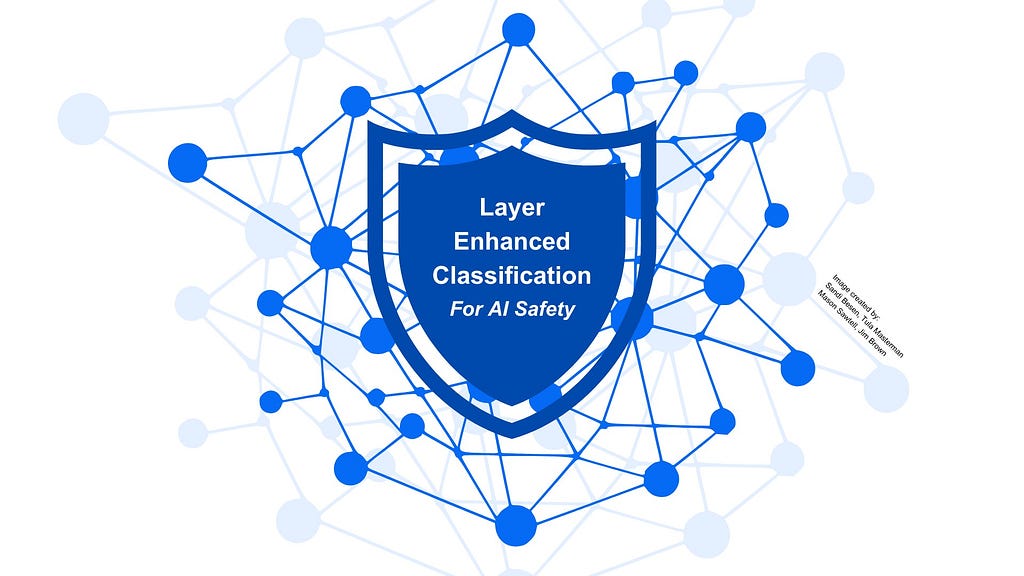
We prove LEC combines the computational efficiency of a machine learning classifier with the sophisticated language understanding of an LLM — so you don’t have to choose between cost, speed, and accuracy. LEC surpasses best in class models like GPT-4o and models specifically trained for identifying unsafe content and prompt injections. What’s better yet, we believe LEC can be modified to tackle non AI safety related text classification tasks like sentiment analysis, intent classification, product categorization, and more.
The implications are profound. Whether you’re a technology leader navigating the complex terrain of AI safety, a product manager mitigating potential risks, or an executive charting a responsible innovation strategy, our approach offers a scalable and adaptable solution.
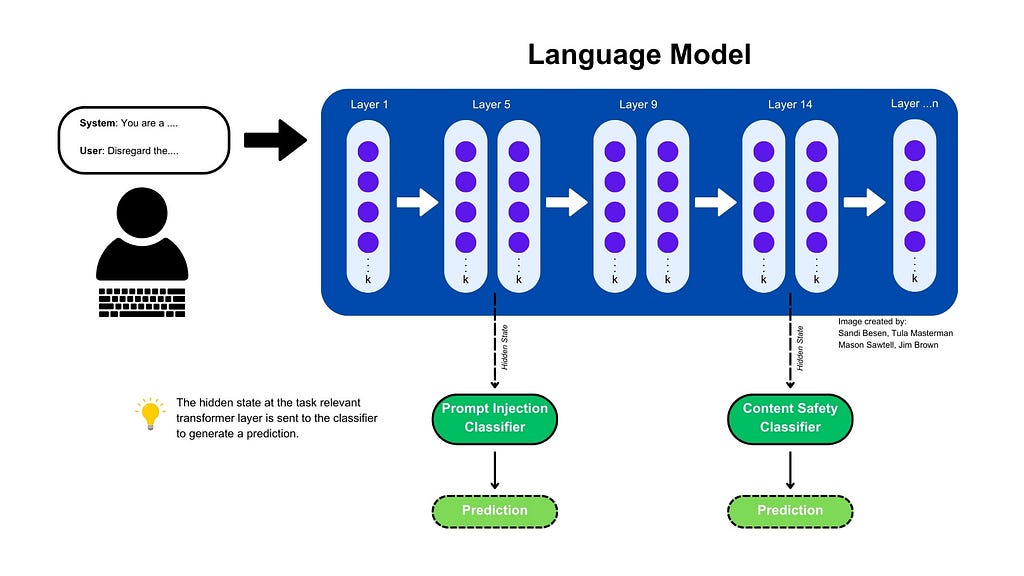
Further details can be found in the full paper’s pre-print on Arxiv[2] or in Tula Masterman’s summarized article about the paper.
Responsible AI has become a critical priority for technology leaders across the ecosystem — from model developers like Anthropic, OpenAI, Meta, Google, and IBM to enterprise consulting firms and AI service providers. As AI adoption accelerates, its importance becomes even more pronounced.
Our research specifically targets two pivotal challenges in AI safety — content safety and prompt injection detection. Content safety refers to the process of identifying and preventing the generation of harmful, inappropriate, or potentially dangerous content that could pose risks to users or violate ethical guidelines. Prompt injection involves detecting attempts to manipulate AI systems by crafting input prompts designed to bypass safety mechanisms or coerce the model into producing unethical outputs.
To advance the field of ethical AI, we applied LEC’s capabilities to real-world responsible AI use cases. Our hope is that this methodology will be adopted widely, helping to make every AI system less vulnerable to exploitation.
We curated a content safety dataset of 5,000 examples to test LEC on both binary (2 categories) and multi-class (>2 categories) classification. We used the SALAD Data dataset from OpenSafetyLab [3] to represent unsafe content and the “LMSYS-Chat-1M” dataset from LMSYS, to represent safe content [4].
For binary classification the content is either “safe” or “unsafe”. For multi-class classification, content is either categorized as “safe” or assigned to a specific specific “unsafe” category.
We compared model’s trained using LEC to GPT-4o (widely recognized as an industry leader), Llama Guard 3 1B and Llama Guard 3 8B (special purpose models specifically trained to tackle content safety tasks). We found that the models using LEC outperformed all models we compared them to using as few as 20 training examples for binary classification and 50 training examples for multi-class classification.
The highest performing LEC model achieved a weighted F1 score (measures how well a system balances making correct predictions while minimizing mistakes) of .96 of a maximum score of 1 on the binary classification task compared to GPT-4o’s score of 0.82 or LlamaGuard 8B’s score of 0.71.
This means that with as few as 15 examples, using LEC you can train a model to outperform industry leaders in identifying safe or unsafe content at a fraction of the computational cost.
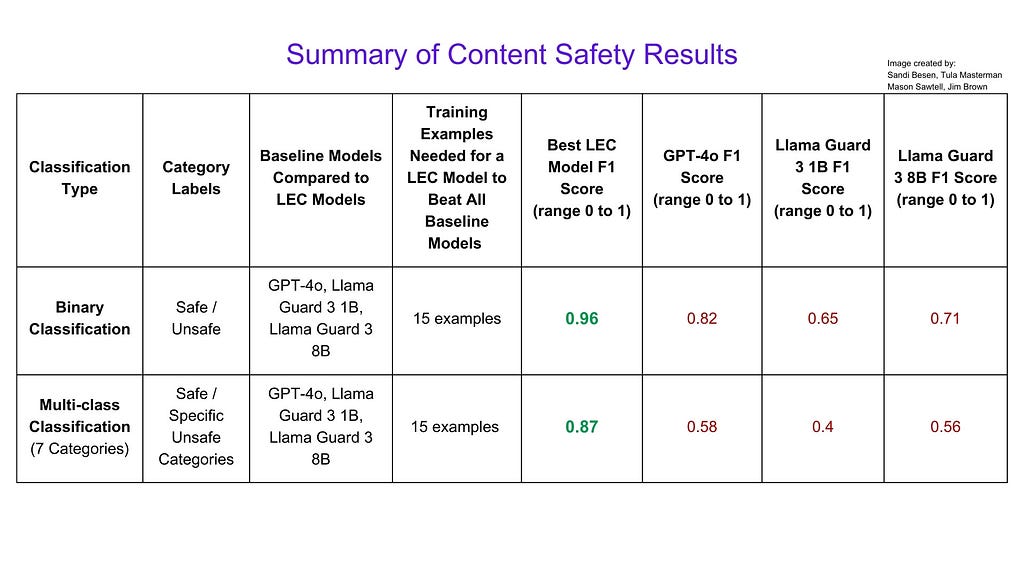
We curated a prompt injection dataset using the SPML Chatbot Prompt Injection Dataset. We chose the SPML dataset because of its diversity and complexity in representing real-world chat bot scenarios. This dataset contained pairs of system and user prompts to identify user prompts that attempt to defy or manipulate the system prompt. This is especially relevant for businesses deploying public facing chatbots that are only meant to answer questions about specific domains.
We compared model’s trained using LEC to GPT-4o (an industry leader) and deBERTa v3 Prompt Injection v2 (a model specifically trained to identify prompt injections). We found that the models using LEC outperformed both GPT-4o using 55 training examples and the the special purpose model using as few as 5 training examples.
The highest performing LEC model achieved a weighted F1 score of .98 of a maximum score of 1 compared to GPT-4o’s score of 0.92 or deBERTa v2 Prompt Injection v2’s score of 0.73.
This means that with as few as 5 examples, using LEC you can train a model to outperform industry leaders in identifying prompt injection attacks.
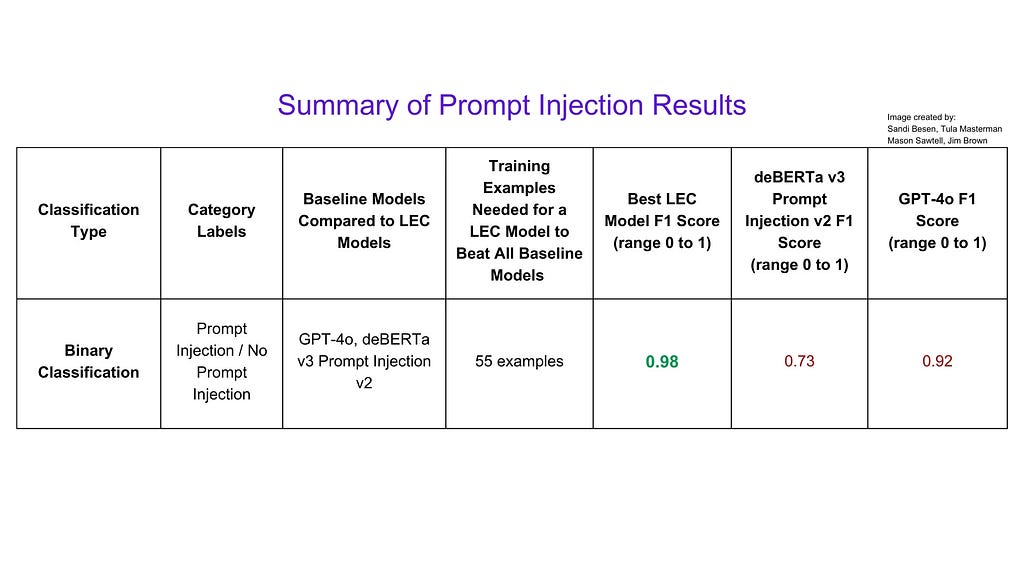
Full results and experimentation implementation details can be found in the Arxiv preprint.
As organizations increasingly integrate AI into their operations, ensuring the safety and integrity of AI-driven interactions has become mission-critical. LEC provides a robust and flexible way to ensure that potentially unsafe information is being detected — resulting in reduce operational risk and increased end user trust. There are several ways that a LEC models can be incorporated into your AI Safety Toolkit to prevent unwanted vulnerabilities when using your AI tools including during LM inference, before/after LM inference, and even in multi-agent scenarios.
During LM Inference
If you are using an open-source model or have access to the inner workings of the closed-source model, you can use LEC as part of your inference pipeline for AI safety in near real time. This means that if any safety concerns arise while information is traveling through the language model, generation of any output can be halted. An example of what this might look like can be seen in figure 1.
Before / After LM Inference
If you don’t have access to the inner workings of the language model or want to check for safety concerns as a separate task you can use a LEC model before or after calling a language model. This makes LEC compatible with closed source models like the Claude and GPT families.
Building a LEC Classifier into your deployment pipeline can save you from passing potentially harmful content into your LM and/or check for harmful content before an output is returned to the user.
Using LEC Classifiers with Agents
Agentic AI systems can amplify any existing unintended actions, leading to a compounding effect of unintended consequences. LEC Classifiers can be used at different times throughout an agentic scenario to can safeguard the agent from either receiving or producing harmful outputs. For instance, by including LEC models into your agentic architecture you can:
How to Implement LEC Based on Language Model Access
Enterprises with access to the internal workings of models can integrate LEC directly within the inference pipeline, enabling continuous safety monitoring throughout the AI’s content generation process. When using closed-source models via API (as is the case with GPT-4), businesses do not have direct access to the underlying information needed to train a LEC model. In this scenario, LEC can be applied before and/or after model calls. For example, before an API call, the input can be screened for unsafe content. Post-call, the output can be validated to ensure it aligns with business safety protocols.
No matter which way you choose to implement LEC, using its powerful abilities provides you with superior content safety and prompt injection protection than existing techniques at a fraction of the time and cost.
Layer Enhanced Classification (LEC) is the safety belt for that AI rocket ship we’re on.
The value proposition is clear: LEC’s AI Safety models can mitigate regulatory risk, help ensure brand protection, and enhance user trust in AI-driven interactions. It signals a new era of AI development where accuracy, speed, and cost aren’t competing priorities and AI safety measures can be addressed both at inference time, before inference time, or after inference time.
In our content safety experiments, the highest performing LEC model achieved a weighted F1 score of 0.96 out of 1 on binary classification, significantly outperforming GPT-4o’s score of 0.82 and LlamaGuard 8B’s score of 0.71 — and this was accomplished with as few as 15 training examples. Similarly, in prompt injection detection, our top LEC model reached a weighted F1 score of 0.98, compared to GPT-4o’s 0.92 and deBERTa v2 Prompt Injection v2’s 0.73, and it was achieved with just 55 training examples. These results not only demonstrate superior performance, but also highlight LEC’s remarkable ability to achieve high accuracy with minimal training data.
Although our work focused on using LEC Models for AI safety use cases, we anticipate that our approach can be used for a wider variety of text classification tasks. We encourage the research community to use our work as a stepping stone for exploring what else can be achieved — further open new pathways for more intelligent, safer, and more trustworthy AI systems.
Note: The opinions expressed both in this article and paper are solely those of the authors and do not necessarily reflect the views or policies of their respective employers.
Interested in connecting? Drop me a DM on Linkedin! I‘m always eager to engage in food for thought and iterate on my work.
References:
[2] https://arxiv.org/abs/2412.13435
[3] https://huggingface.co/datasets/OpenSafetyLab/Salad-Data
[4] https://huggingface.co/datasets/lmsys/lmsys-chat-1m
A New Approach to AI Safety: Layer Enhanced Classification (LEC) was originally published in Towards Data Science on Medium, where people are continuing the conversation by highlighting and responding to this story.
Originally appeared here:
A New Approach to AI Safety: Layer Enhanced Classification (LEC)
Go Here to Read this Fast! A New Approach to AI Safety: Layer Enhanced Classification (LEC)

Originally published at https://blog.developer.bazaarvoice.com on October 28, 2024.
Large language models are fantastic tools for unstructured text, but what if your text doesn’t fit in the context window? Bazaarvoice faced exactly this challenge when building our AI Review Summaries feature: millions of user reviews simply won’t fit into the context window of even newer LLMs and, even if they did, it would be prohibitively expensive.
In this post, I share how Bazaarvoice tackled this problem by compressing the input text without loss of semantics. Specifically, we use a multi-pass hierarchical clustering approach that lets us explicitly adjust the level of detail we want to lose in exchange for compression, regardless of the embedding model chosen. The final technique made our Review Summaries feature financially feasible and set us up to continue to scale our business in the future.
Bazaarvoice has been collecting user-generated product reviews for nearly 20 years so we have a lot of data. These product reviews are completely unstructured, varying in length and content. Large language models are excellent tools for unstructured text: they can handle unstructured data and identify relevant pieces of information amongst distractors.
LLMs have their limitations, however, and one such limitation is the context window: how many tokens (roughly the number of words) can be put into the network at once. State-of-the-art large language models, such as Athropic’s Claude version 3, have extremely large context windows of up to 200,000 tokens. This means you can fit small novels into them, but the internet is still a vast, every-growing collection of data, and our user-generated product reviews are no different.
We hit the context window limit while building our Review Summaries feature that summarizes all of the reviews of a specific product on our clients website. Over the past 20 years, however, many products have garnered thousands of reviews that quickly overloaded the LLM context window. In fact, we even have products with millions of reviews that would require immense re-engineering of LLMs to be able to process in one prompt.
Even if it was technically feasible, the costs would be quite prohibitive. All LLM providers charge based on the number of input and output tokens. As you approach the context window limits for each product, of which we have millions, we can quickly run up cloud hosting bills in excess of six figures.
To ship Review Summaries despite these technical, and financial, limitations, we focused on a rather simple insight into our data: Many reviews say the same thing. In fact, the whole idea of a summary relies on this: review summaries capture the recurring insights, themes, and sentiments of the reviewers. We realized that we can capitalize on this data duplication to reduce the amount of text we need to send to the LLM, saving us from hitting the context window limit and reducing the operating cost of our system.
To achieve this, we needed to identify segments of text that say the same thing. Such a task is easier said than done: often people use different words or phrases to express the same thing.
Fortunately, the task of identifying if text is semantically similar has been an active area of research in the natural language processing field. The work by Agirre et. al. 2013 (SEM 2013 shared task: Semantic Textual Similarity. In Second Joint Conference on Lexical and Computational Semantics) even published a human-labeled data of semantically similar sentences known as the STS Benchmark. In it, they ask humans to indicate if textual sentences are semantically similar or dissimilar on a scale of 1–5, as illustrated in the table below (from Cer et. al., SemEval-2017 Task 1: Semantic Textual Similarity Multilingual and Crosslingual Focused Evaluation):
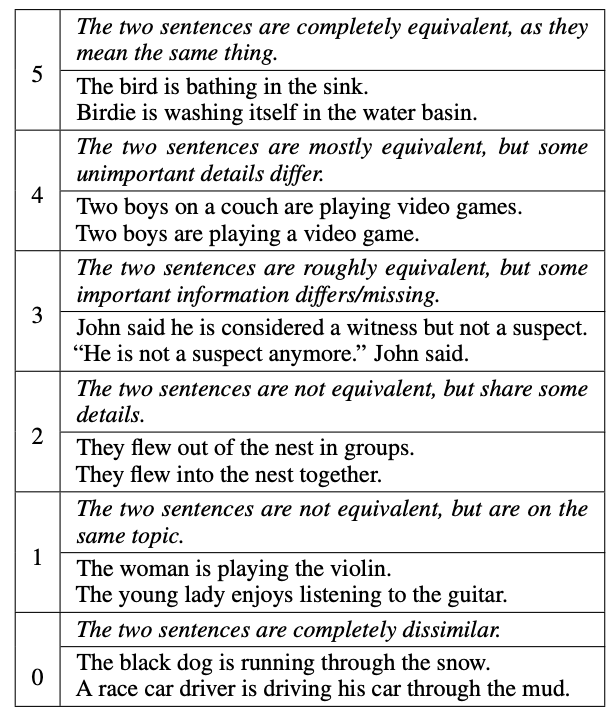
The STSBenchmark dataset is often used to evaluate how well a text embedding model can associate semantically similar sentences in its high-dimensional space. Specifically, Pearson’s correlation is used to measure how well the embedding model represents the human judgements.
Thus, we can use such an embedding model to identify semantically similar phrases from product reviews, and then remove repeated phrases before sending them to the LLM.
Our approach is as follows:
This may seem straightforward when written in a bulleted list, but there were some devils in the details we had to sort out before we could trust this approach.
First, we had to ensure the model we used effectively embedded text in a space where semantically similar sentences are close, and semantically dissimilar ones are far away. To do this, we simply used the STS benchmark dataset and computed the Pearson correlation for the models we desired to consider. We use AWS as a cloud provider, so naturally we wanted to evaluate their Titan Text Embedding models.
Below is a table showing the Pearson’s correlation on the STS Benchmark for different Titan Embedding models:
(State of the art is visible here)
So AWS’s embedding models are quite good at embedding semantically similar sentences. This was great news for us — we can use these models off the shelf and their cost is extremely low.
The next challenge we faced was: how can we enforce semantic similarity during clustering? Ideally, no cluster would have two sentences whose semantic similarity is less than humans can accept — a score of 4 in the table above. Those scores, however, do not directly translate to the embedding distances, which is what is needed for agglomerative clustering thresholds.
To deal with this issue, we again turned to the STS benchmark dataset. We computed the distances for all pairs in the training dataset, and fit a polynomial from the scores to the distance thresholds.
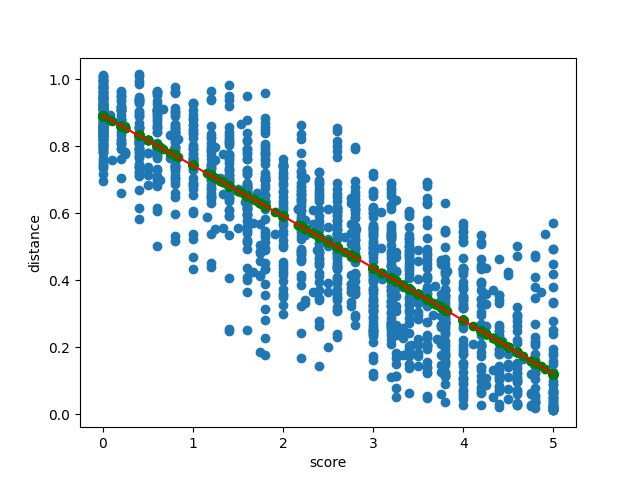
This polynomial lets us compute the distance threshold needed to meet any semantic similarity target. For Review Summaries, we selected a score of 3.5, so nearly all clusters contain sentences that are “roughly” to “mostly” equivalent or more.
It’s worth noting that this can be done on any embedding network. This lets us experiment with different embedding networks as they become available, and quickly swap them out should we desire without worrying that the clusters will have semantically dissimilar sentences.
Up to this point, we knew we could trust our semantic compression, but it wasn’t clear how much compression we could get from our data. As expected, the amount of compression varied across different products, clients, and industries.
Without loss of semantic information, i.e., a hard threshold of 4, we only achieved a compression ratio of 1.18 (i.e., a space savings of 15%).
Clearly lossless compression wasn’t going to be enough to make this feature financially viable.
Our distance selection approach discussed above, however, provided an interesting possibility here: we can slowly increase the amount of information loss by repeatedly running the clustering at lower thresholds for remaining data.
The approach is as follows:
So, at each pass of the clustering, we’re sacrificing more information loss, but getting more compression and not muddying the lossless representative phrases we selected during the first pass.
In addition, such an approach is extremely useful not only for Review Summaries, where we want a high level of semantic similarity at the cost of less compression, but for other use cases where we may care less about semantic information loss but desire to spend less on prompt inputs.
In practice, there are still a significantly large number of clusters with only a single vector in them even after dropping the score threshold a number of times. These are considered outliers, and are randomly sampled for inclusion in the final prompt. We select the sample size to ensure the final prompt has 25,000 tokens, but no more.
The multi-pass clustering and random outlier sampling permits semantic information loss in exchange for a smaller context window to send to the LLM. This raises the question: how good are our summaries?
At Bazaarvoice, we know authenticity is a requirement for consumer trust, and our Review Summaries must stay authentic to truly represent all voices captured in the reviews. Any lossy compression approach runs the risk of mis-representing or excluding the consumers who took time to author a review.
To ensure our compression technique was valid, we measured this directly. Specifically, for each product, we sampled a number of reviews, and then used LLM Evals to identify if the summary was representative of and relevant to each review. This gives us a hard metric to evaluate and balance our compression against.
Over the past 20 years, we have collected nearly a billion user-generated reviews and needed to generate summaries for tens of millions of products. Many of these products have thousands of reviews, and some up to millions, that would exhaust the context windows of LLMs and run the price up considerably.
Using our approach above, however, we reduced the input text size by 97.7% (a compression ratio of 42), letting us scale this solution for all products and any amount of review volume in the future.
In addition, the cost of generating summaries for all of our billion-scale dataset reduced 82.4%. This includes the cost of embedding the sentence data and storing them in a database.
Semantically Compress Text to Save On LLM Costs was originally published in Towards Data Science on Medium, where people are continuing the conversation by highlighting and responding to this story.
Originally appeared here:
Semantically Compress Text to Save On LLM Costs
Go Here to Read this Fast! Semantically Compress Text to Save On LLM Costs
Go Here to Read this Fast! How to use Visual Intelligence on your iPhone with iOS 18.2
Originally appeared here:
How to use Visual Intelligence on your iPhone with iOS 18.2
Go Here to Read this Fast! Best apps for tracking Santa on your phone
Originally appeared here:
Best apps for tracking Santa on your phone
Go Here to Read this Fast! We called the WF-1000XM5 “Sony’s best buds,” and now they’re $100 cheaper
Originally appeared here:
We called the WF-1000XM5 “Sony’s best buds,” and now they’re $100 cheaper
Movie icon and super spy James Bond seemed to be on another rise to the top of the box office just a few years ago, but things have been almost as quiet as a shot from a Walther PPK with a silencer ever since then. Daniel Craig took on the role in 2006 with Casino Royale and passed the baton with 2021’s No Time to Die in one of the most heart-wrenching endings in Bond’s cinematic history (you cried, just admit it).
The only thing sadder is the reason why we haven’t seen a new Bond movie since then.
The Wall Street Journal reports that Amazon and Barbara Broccoli, the producer who inherited the franchise from her father and film producer Albert “Cubby” Broccoli when he died in 1996, are in the middle of an ugly fight that’s halted production on the next Bond film. Apparently, Barbara doesn’t trust Amazon with her family’s famous film franchise.
How bad is it? Well, here’s a quote from Barbara to some of her friends explaining how she feels about the people who run Amazon’s media empire: “These people are f—ing idiots.” Man, that’s awkward with a capital “awk.”
The stalemate started back in 2021 when Amazon bought MGM for $8.5 billion and thus acquired the rights to distribute Bond films, according to Variety. The deal seemed like a big move for Amazon to weave its way into Hollywood using one of its most storied and rock solid film franchises.
Unfortunately for Amazon, the true power over the James Bond films lies with Broccoli. She supplies the ideas for Bond’s big screen adventures and when they go into production, and Broccoli isn’t keen on working with Amazon anytime soon. The WSJ spoke to 20 people familiar with the feud who say Broccoli feels Amazon isn’t the right place for a Bond movie because its core business is retail and ecommerce.
When Amazon purchased MGM, clinching the rights to the Bond franchise was a key part of the deal’s value. Broccoli and co-producer Michael Wilson had some reservations but were assured they would still retain creative control. COVID lockdowns were already making it hard to jump into the next Bond film production as well. However, things seemed to be smoothing over between the two parties when Amazon also insisted that its next Bond movie No Time to Die would get a theatrical release.
But as soon as the deal closed, Amazon executives started thinking of ways to expand the Bond film franchise to other mediums like a Moneypenny spinoff series for Prime Video or a separate spy film or TV show that took place in the Bond universe. Broccoli refused to let any of these projects go forward. She also took umbrage with Amazon entertainment executive Jennifer Salke’s use of the word “content” to describe new James Bond projects and any ideas Amazon had for Bond were labeled “TBD” in memos. To date, the only Bond property Amazon could get Broccoli to sign off on is a reality series 007: Road to a Million that’s entering its second season.
Broccoli and her family have been part of the Bond movie franchise for almost as long as she lived so she’s fiercely protective of the brand and her father’s cinematic legacy. She’s also started training Wilson’s son Gregg to produce recent installments and possibly prepare him to take over the franchise someday. Even that has led to disagreements over who should play Bond in the next film. That’s assuming we get one and it doesn’t look like that will happen anytime soon.
This article originally appeared on Engadget at https://www.engadget.com/entertainment/tv-movies/james-bond-the-movie-franchise-not-the-spy-may-be-in-deep-jeopardy-211608094.html?src=rss
Go Here to Read this Fast! James Bond (the movie franchise, not the spy) may be in deep jeopardy
Originally appeared here:
James Bond (the movie franchise, not the spy) may be in deep jeopardy
A little more than a week after announcing Gemini Deep Research, Google is making the tool available to more people. As of today, the feature, part of the company’s paid Gemini Advanced suite, is available in every country and language where Google offers Gemini. In practice, that means Gemini Advanced users in more than 100 countries globally can start using Deep Research right now. Previously, it was only available in English.
As a refresher, Deep Research takes advantage of Gemini 1.5 Pro’s ability to reason through “long context windows” to create comprehensive but easy-to-read reports on complex topics. Once you provide the tool a prompt, it will generate a research plan for you to approve and tweak as you see fit. After it has your go-ahead, Gemini 1.5 Pro will search the open web for information related to your query. That process can sometimes take several minutes, but once Gemini is done, you’ll have a multi-page report you can export to Google Docs for later viewing.
This article originally appeared on Engadget at https://www.engadget.com/ai/googles-gemini-deep-research-tool-is-now-available-globally-210151873.html?src=rss